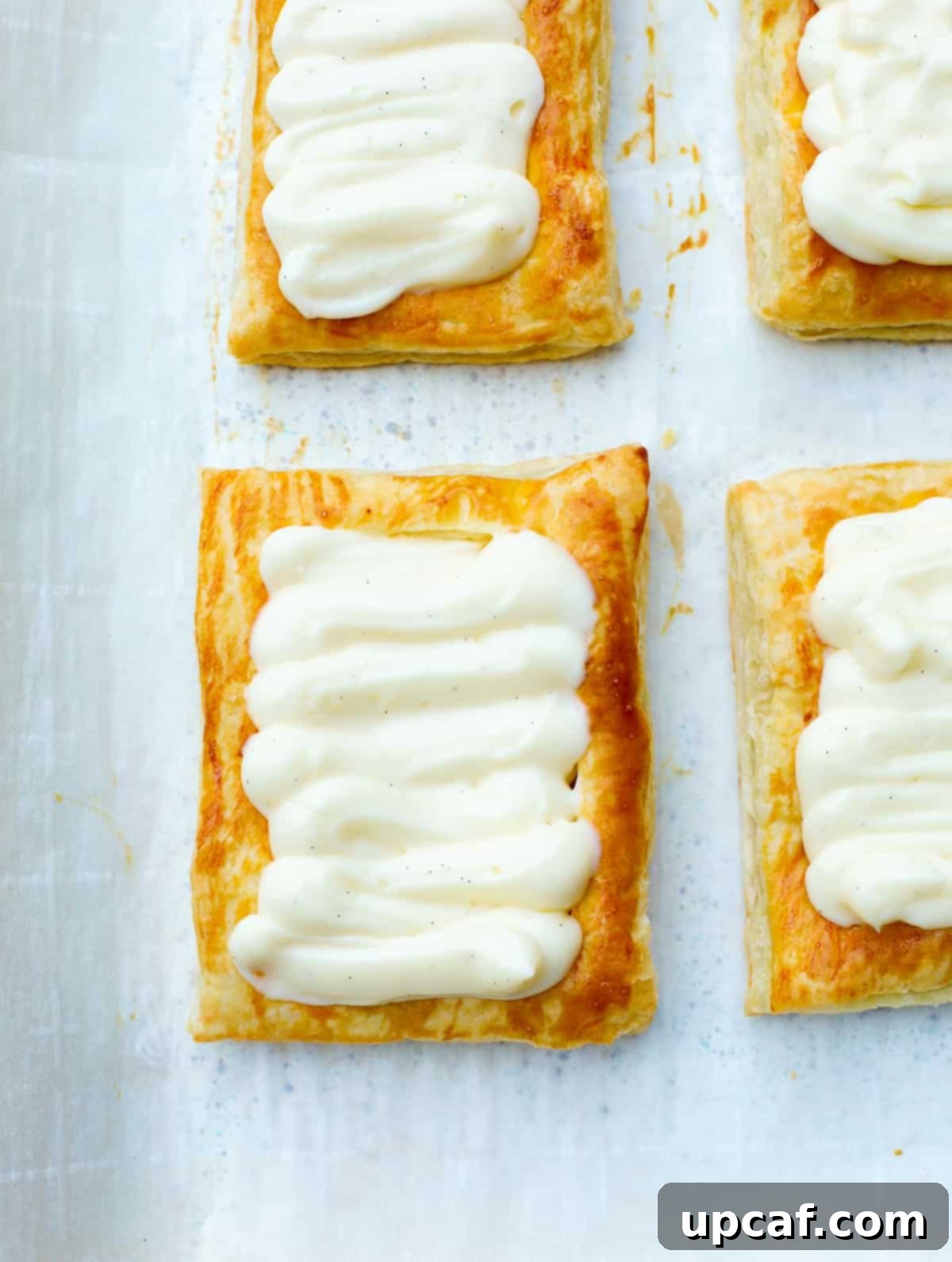Pastry Cream, often celebrated by its elegant French name, Crème Pâtissière, stands as a cornerstone in the world of delectable desserts. This velvety, rich custard is a foundational element in countless iconic sweet treats, gracing patisseries and home kitchens across the globe. Its allure lies not just in its exquisite flavor and smooth texture, but also in its surprising simplicity and the convenience of being prepared in advance, significantly streamlining the process for your culinary adventures. Imagine the ease of whipping up this essential component ahead of time, allowing you to assemble breathtaking desserts with minimal last-minute fuss.

Once you master this versatile vanilla pastry cream, a world of dessert possibilities opens up. Many beloved recipes depend on a perfectly made Crème Pâtissière. To truly appreciate its utility and deliciousness, consider preparing a larger batch to use throughout the week or weekend. This foresight drastically cuts down on prep time when you decide to embark on more ambitious baking projects. For inspiration, be sure to explore my delightful Pain Aux Raisins, the refreshing Strawberry French Tart, and the vibrant Raspberry Puff Pastry Tart, all of which beautifully showcase this incredible custard.
What is Pastry Cream? The Heart of French Patisserie
Pastry Cream, or Crème Pâtissière, is much more than a simple custard; it’s a foundational French culinary art form. At its core, it’s a thick, creamy, vanilla-infused custard filling, akin to a richer, more structured pudding, but uniquely designed to hold its shape and withstand baking within pastries. This makes it an indispensable component in a vast array of French pastries and beloved desserts worldwide. Unlike thinner custards or pouring creams, pastry cream achieves its characteristic firm yet tender consistency through the careful combination of egg yolks and a starch thickener, typically cornstarch.
The main ingredients are fundamental: rich whole milk, vibrant egg yolks, granulated sugar for sweetness and structure, a precise amount of starch (most commonly cornstarch) for thickening, and the star flavoring – vanilla. While a true vanilla bean pod offers an unparalleled depth of flavor and visual appeal with its tiny black seeds, pure vanilla extract is a perfectly acceptable and widely used substitute. Beyond vanilla, other flavorings like lemon zest or orange zest can be incorporated to introduce a bright, citrusy note. However, it’s worth noting that these additions will subtly alter the classic vanilla profile, and many purists prefer to let the exquisite taste of vanilla shine unadulterated.
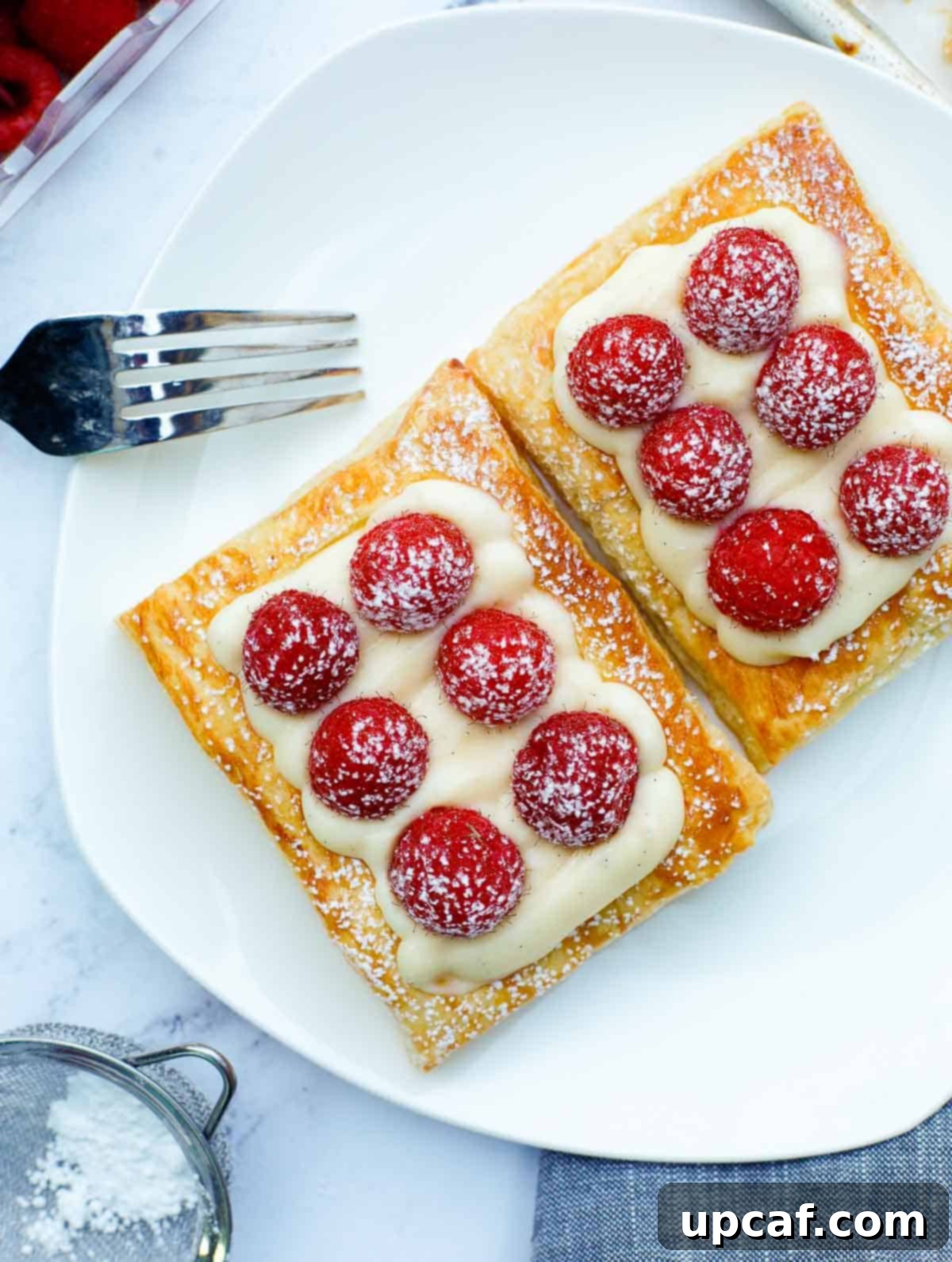
Why You’ll Adore This Homemade Pastry Cream Recipe
Creating your own pastry cream might sound intimidating, but this recipe is designed to make it approachable, enjoyable, and incredibly rewarding. Here’s why you’ll quickly fall in love with making your own Crème Pâtissière:
- No Special Kitchen Equipment Needed: Forget about needing fancy gadgets or professional pastry tools. This recipe requires nothing more than the basic kitchen essentials you likely already own. A simple saucepan for heating the milk, a sturdy whisk for combining ingredients and achieving that perfect smooth texture, and a heat-safe bowl are all you need. This accessibility means anyone can whip up a batch of delicious pastry cream without investing in specialized gear, making gourmet desserts within reach for every home cook.
- Made with Everyday Staple Ingredients: One of the greatest advantages of this pastry cream recipe is that it relies on ingredients that are almost always stocked in a well-equipped kitchen. Whole milk, eggs, sugar, cornstarch, butter, and vanilla – these are common items, not obscure specialty components. This ensures that you can decide to make a batch on a whim, without a special trip to the grocery store. The convenience of having everything on hand means you can satisfy your craving for delicious, homemade desserts anytime inspiration strikes.
- Achieve Restaurant-Quality Results with Ease: The name “Crème Pâtissière” might evoke images of complicated, professional-level baking, but this recipe demystifies the process. You’ll be amazed at how simple it is to produce a silky, rich, and incredibly flavorful pastry cream that rivals those found in high-end bakeries and restaurants. The satisfaction of creating such an elegant, versatile filling from scratch, right in your own kitchen, is immense. It’s a wonderful way to elevate your home baking and impress friends and family with seemingly elaborate desserts that are surprisingly easy to make.
The Essential Ingredients for Perfect Vanilla Pastry Cream
Each component in pastry cream plays a crucial role in achieving its signature flavor and luxurious texture. Understanding why each ingredient is essential will help you create a truly exceptional Crème Pâtissière every time.

- Whole Milk: This is not an ingredient to compromise on. Using full-fat, whole milk is absolutely paramount for achieving the characteristic richness and incredibly creamy texture of authentic pastry cream. The higher fat content of whole milk contributes significantly to the custard’s luscious mouthfeel, body, and overall indulgence. Lower-fat milks will result in a thinner, less satisfying cream that lacks the depth of flavor you’re aiming for.
- Vanilla Bean or Pure Vanilla Extract: Vanilla is the soul of classic pastry cream. For the most profound and authentic vanilla flavor, a fresh vanilla bean pod is the gold standard. You can scrape the seeds into the milk and infuse the pod itself. Alternatively, a high-quality vanilla bean paste offers a good compromise, providing visible vanilla flecks and robust flavor. If these are unavailable, pure vanilla extract is an excellent and convenient choice. Ensure it’s pure vanilla extract, not imitation, for the best results.
- Granulated Sugar: Beyond simply adding sweetness, granulated sugar plays a structural role in pastry cream. It helps to stabilize the egg yolks and contributes to the custard’s smooth consistency. The amount of sugar can be slightly adjusted to your personal preference – a little more for a sweeter cream, or a little less if you prefer it subtler, especially when pairing with very sweet fruits or toppings.
- Egg Yolks: The heart of any true custard, egg yolks are the primary base ingredient for Crème Pâtissière. They impart a beautiful golden color, incredible richness, and contribute significantly to the cream’s emulsified, velvety texture. Using only yolks, rather than whole eggs, ensures a denser, more luxurious custard that holds its shape wonderfully.
- Cornstarch: This is the critical thickening agent that transforms the liquid mixture into a firm, spoonable cream. Cornstarch is highly preferred over flour because it creates a much smoother, glossier, and more stable cream, without imparting any starchy flavor. It also makes the pastry cream gluten-free. The starch granules absorb liquid and swell when heated, creating the desired thick consistency.
- Unsalted Butter: Added at the very end of the cooking process, unsalted butter is a magical finishing touch. It melts into the warm custard, contributing an extra layer of richness, a beautiful sheen, and an incredibly smooth, silky mouthfeel. It also helps to prevent a skin from forming as the cream cools and adds to the overall luxuriousness.
- Lemon Zest (Optional): A small amount of finely grated lemon zest can be a wonderful addition, especially if you prefer a pastry cream with a hint of brightness. It adds a subtle, fragrant citrus note that complements the vanilla beautifully without overpowering it. However, if you desire a purely vanilla-focused flavor, feel free to omit it.
How To Master Homemade Pastry Cream (Crème Pâtissière)
Making pastry cream involves a few key steps that, when followed carefully, guarantee a smooth, rich, and perfectly set custard. Let’s walk through the process to create this fundamental dessert filling.
- Prepare the Infused Milk: Begin by measuring out your whole milk. Remove one tablespoon of milk and set it aside in a small bowl; this will be used later. Pour the remaining milk into a medium saucepan. If you are using a vanilla bean pod, carefully slice it lengthwise with a sharp knife and scrape out the tiny seeds. Add both the seeds and the empty vanilla bean stalk to the milk in the saucepan. Gently bring the milk to a bare simmer over low-medium heat, just until small bubbles appear around the edges. Do not let it boil vigorously. If using vanilla extract, hold off on adding it until the next step. The gentle heat allows the vanilla to infuse deeply into the milk, creating a fragrant base.
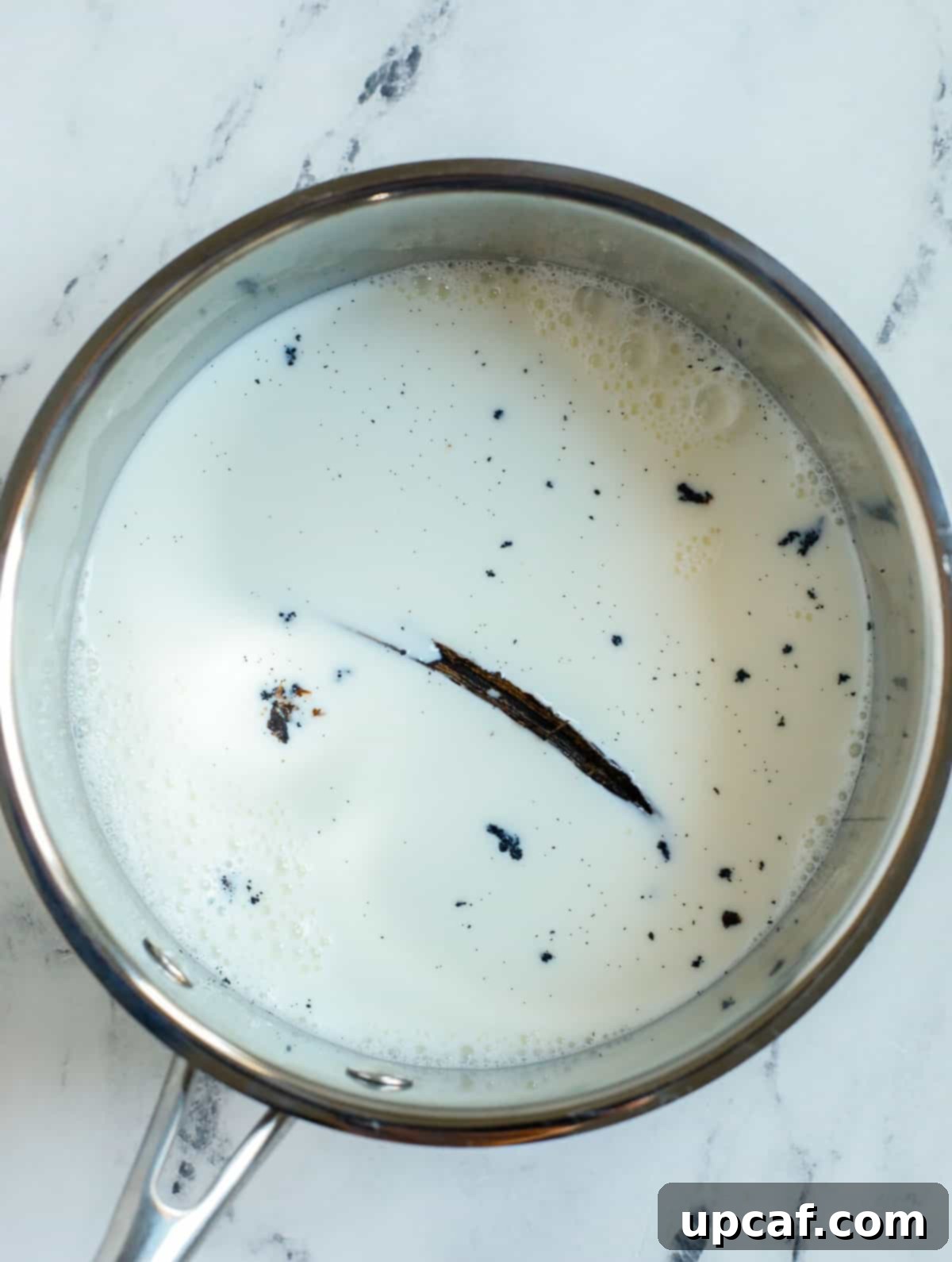
- Create the Egg Yolk Mixture: While your milk is gently simmering, prepare the egg yolk mixture. In a separate, heat-proof medium bowl, add the egg yolks, granulated sugar, cornstarch, and lemon zest (if you are using it). If you opted for vanilla extract instead of a vanilla bean, add it to this bowl now. Vigorously whisk these ingredients together until the mixture becomes pale yellow, thick, and smooth. Initially, it might appear clumpy, but keep whisking. Now, add the reserved 1 tablespoon of cold milk to this egg yolk mixture. Continue whisking until the mixture is completely smooth, slightly fluffy, and uniform in consistency. This step is crucial for preventing lumps later.
- Temper the Egg Mixture: This is a critical step to prevent the egg yolks from scrambling when introduced to the hot milk. Once the milk reaches a simmer, remove the vanilla bean stalk if used. Slowly, in a thin, steady stream, pour about half of the hot milk into the egg yolk mixture while continuously whisking. Whisking constantly and slowly adding the hot milk raises the temperature of the egg yolks gradually, tempering them. This ensures a silky smooth custard without any cooked egg bits.
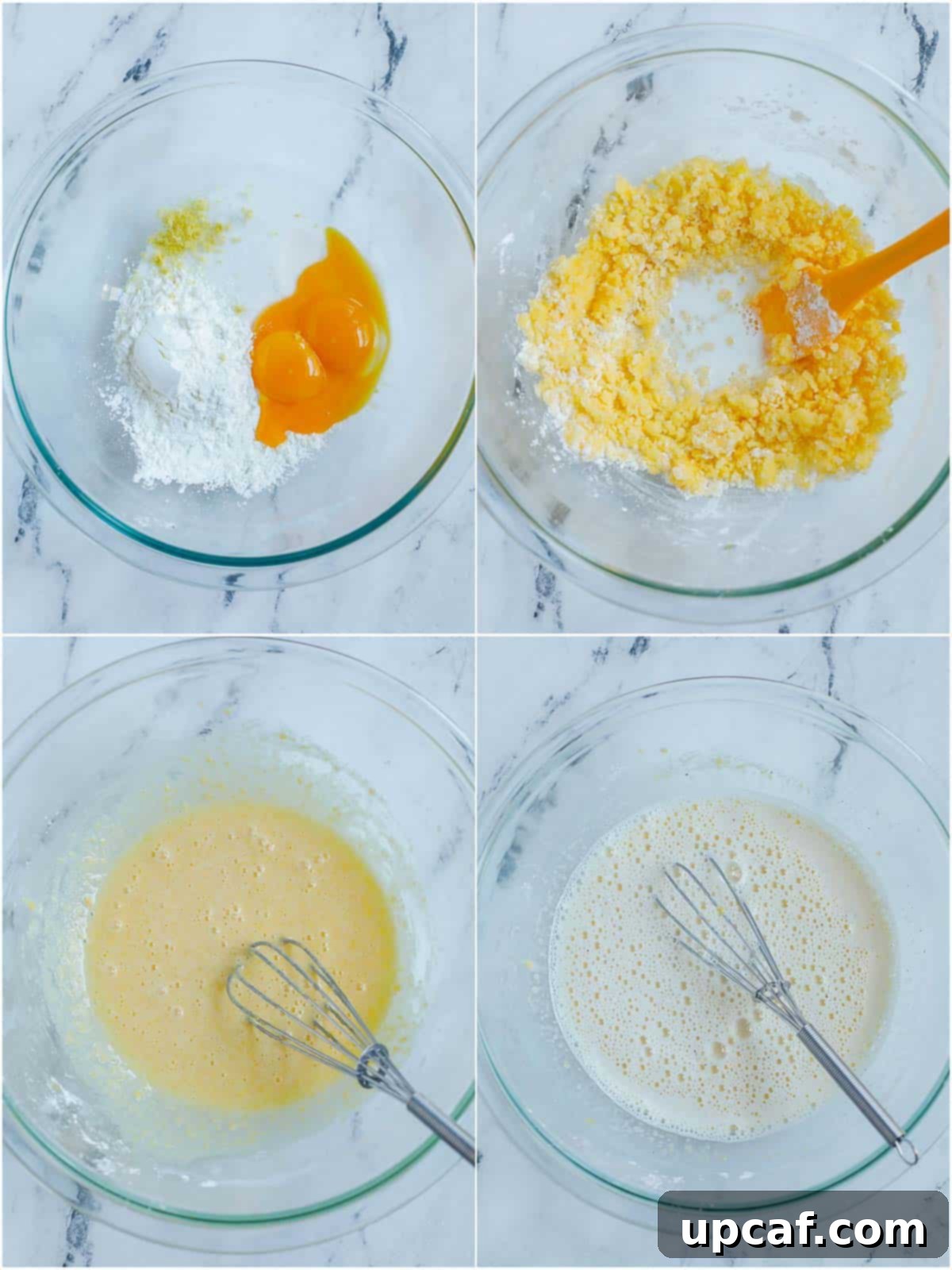
- Cook the Crème Pâtissière to Perfection: Using a fine-mesh strainer, pour the tempered milk and egg mixture back into the original saucepan. This straining step is highly recommended as it catches any small clumps from the egg mixture or pieces of vanilla bean, ensuring a perfectly smooth custard. Place the saucepan back over medium heat and continue to whisk continuously and vigorously. Do not stop whisking, especially as the mixture begins to thicken, to prevent it from sticking to the bottom, scorching, or forming lumps. The cream will start to thicken noticeably within a few minutes, turning glossy and pudding-like. Bring it to a gentle boil for about 1-2 minutes while still whisking – this ensures the cornstarch is fully cooked out and the cream reaches its maximum thickness and stability.

- Finish with Butter and Cool: Once the custard cream has thickened beautifully and has been cooked for a minute or two after boiling, remove the saucepan from the heat immediately. Add the unsalted butter to the hot cream and whisk vigorously until it is completely melted and fully incorporated. The butter will add a wonderful sheen and extra richness to your pastry cream.

- Proper Cooling: Transfer the finished pastry cream into a clean glass bowl or shallow dish. This helps it cool faster. Immediately press a sheet of plastic wrap directly onto the surface of the cream, ensuring there is no air trapped between the plastic and the custard. This crucial step prevents a “skin” from forming as the cream cools, which can lead to lumps and an undesirable texture. Allow the pastry cream to cool completely at room temperature for about 30-45 minutes before transferring it to the refrigerator to chill thoroughly. Chilling for at least 2-3 hours, or preferably overnight, allows the cream to firm up completely.
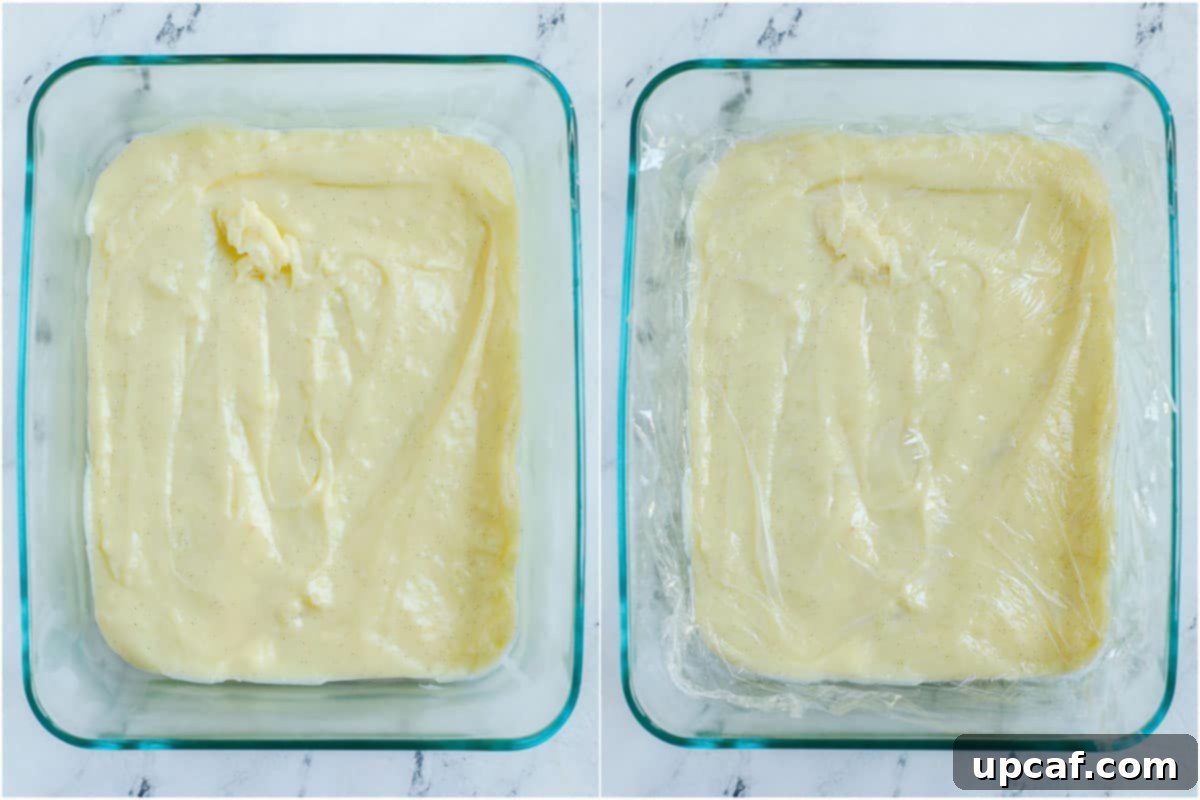
- The Final Whisk for Silky Smoothness: Once the vanilla pastry cream has cooled completely and is firm, it will likely be quite stiff. Before using, transfer it to a clean bowl and whisk it vigorously for about a minute, either by hand or with an electric mixer on low speed. This re-whips the custard, breaking up any stiffness and restoring its incredibly smooth, creamy, and spreadable texture, as beautifully seen in the photo below. This step is essential for achieving that delightful, luxurious mouthfeel.
- Optional: Lighten with Whipped Cream (Crème Légère): For certain applications, such as filling cakes, eclairs, donuts, tarts, or mille-feuille, you might desire a lighter, airier cream. If you are not using the pastry cream for baking within a pastry (where a firmer cream is often needed), you can transform it into a Crème Légère. To do this, whip 1 cup of heavy whipping cream (measured after whipping with some confectioners’ sugar for stability and sweetness) until soft peaks form. Gently fold this whipped cream into your chilled, re-whipped pastry cream. This creates a wonderfully fluffy, less dense filling that is perfect for delicate desserts.

Expert Tips for Crafting Flawless Vanilla Pastry Cream
Achieving a perfect pastry cream is within reach for anyone with these helpful tips and tricks:
- Always Strain for Ultimate Smoothness: I cannot emphasize enough the importance of straining the cream mixture before returning it to the pot for final cooking. This simple step acts as a safety net, eliminating any potential clumps of egg, undissolved cornstarch, or bits from vanilla pods, ensuring your pastry cream is impeccably smooth and velvety.
- Prioritize Full-Fat, Whole Milk: For a truly rich, luxurious, and satisfying Crème Pâtissière, commit to using full-fat, whole milk. The fat content is crucial for the creaminess and body of the custard. Skimping on this will result in a thinner, less flavorful product.
- Whisk Egg Yolks and Sugar Thoroughly: Before tempering, vigorously whisk the egg yolks and granulated sugar together until they are pale in color, slightly fluffy, and perfectly smooth. This process, known as “blanching,” helps to dissolve the sugar, lightens the mixture, and prepares the yolks to emulsify properly.
- Invest in Quality Vanilla: Since vanilla is the star flavor, its quality makes a significant difference. Use pure vanilla extract, a vanilla bean, or vanilla bean paste. Avoid imitation vanilla, as it can impart an artificial taste that detracts from the overall elegance of the cream.
- Temper with Care: When adding the hot milk to the egg yolk mixture, do so slowly, in a thin, continuous stream, while whisking constantly. This gradual addition and constant agitation prevent the eggs from scrambling, allowing them to gently come up to temperature.
- Constant Whisking During Cooking is Key: Once the mixture is back on the heat, do not stop whisking. Pay particular attention to the bottom and corners of the saucepan to prevent scorching and lumps. Whisk until the cream visibly thickens and boils gently for 1-2 minutes to ensure the starch is fully activated and cooked out.
- Re-Whisk After Cooling: Pastry cream will firm up considerably when chilled. Before using, always give it a good whisk for a minute or two. This breaks down the gel structure that forms during cooling, restoring its smooth, spreadable, and creamy consistency.
- Transform into Crème Légère for Lighter Desserts: If your dessert calls for a lighter filling (like for eclairs, cakes, or fruit tarts), incorporate whipped cream. After the pastry cream is fully chilled and re-whisked, gently fold in 1 cup of softly whipped heavy cream (ensure it’s already whipped with a touch of confectioners’ sugar). This creates a delicate, airy cream that still retains the wonderful flavor of your homemade pastry cream.
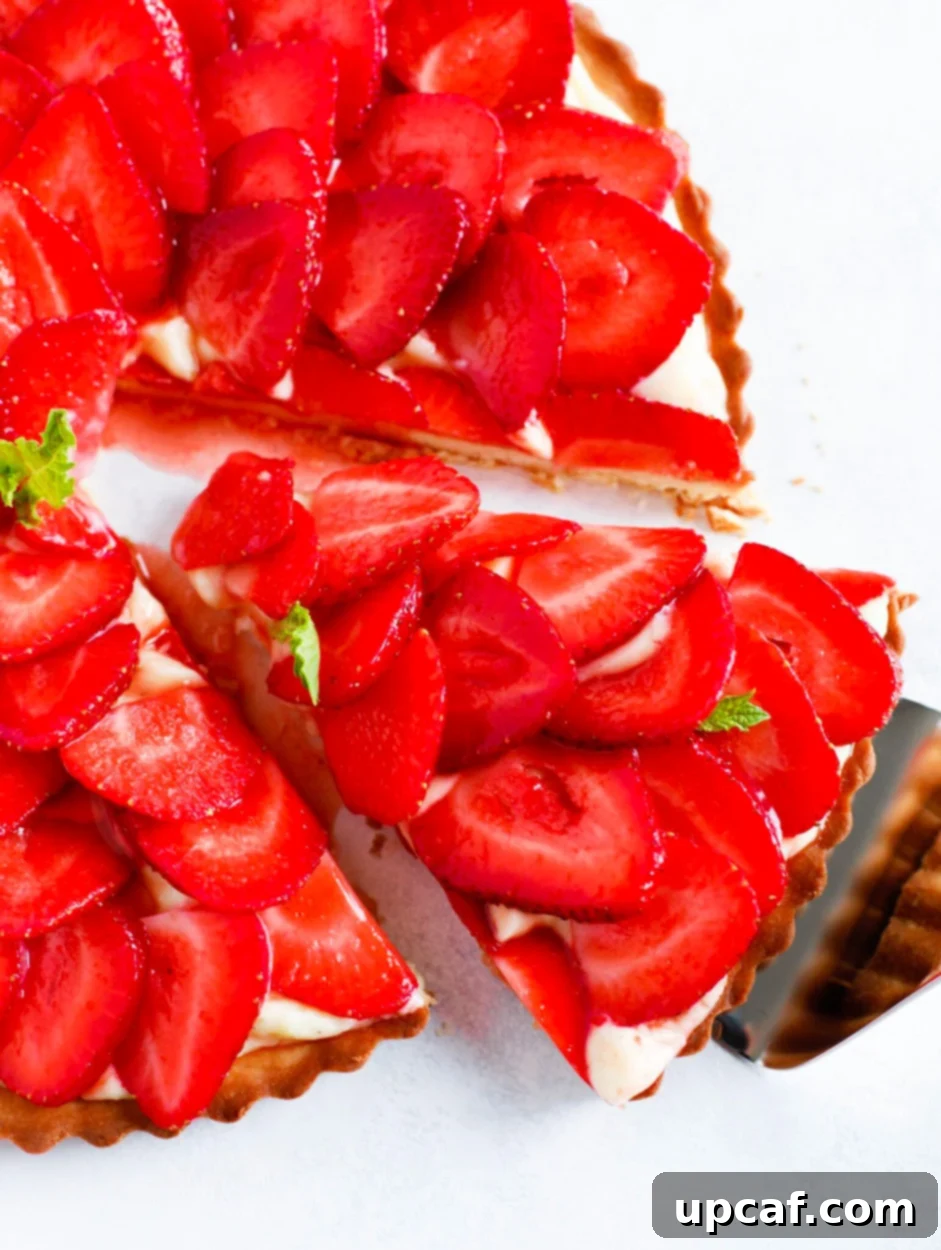
Expand Your Baking Horizons with More Helpful Tutorials
Once you’ve mastered pastry cream, why not explore other essential kitchen techniques and recipes? These tutorials will further enhance your culinary skills:
- How to Melt Chocolate: Essential for any chocolate-based dessert.
- How to Make Ghee: A clarified butter with a rich, nutty flavor, perfect for cooking and baking.
- How to Make Chocolate Ganache: A versatile and luxurious chocolate sauce or frosting.
- How to Make Garlic Sauce (Toum): A surprisingly simple yet incredibly flavorful Lebanese staple.
- How to Make The Perfect Soft Boiled Egg: A fundamental skill for a quick and satisfying meal.
I genuinely hope you enjoy exploring all the recipes I share, including this incredibly versatile and delicious homemade Pastry Cream. It’s a skill that will elevate your dessert game exponentially. Give it a try, savor the results, and don’t forget to rate it and share your culinary successes with your friends and family!
If you love this recipe and find it helpful, please take a moment to leave a star rating and a comment below. Your feedback means the world to me and helps other aspiring bakers. Also, be sure to follow me at Cookin’ With Mima on FACEBOOK |INSTAGRAM |PINTEREST for all my latest culinary inspirations, posts, and recipes.

How to Make Pastry Cream (Crème Pâtissière)
Ingredients
- ▢ 2 cups whole milk, save 1 tbsp on the side
- ▢ 1 tbsp. Vanilla Extract, or ½ tsp Vanilla Bean
- ▢ ⅓ cup corn starch
- ▢ ½ cup granulated sugar
- ▢ 3 whole egg yolks
- ▢ 2 tbsps. butter, unsalted
- ▢ ¼ tsp. lemon zest, optional
Whip Cream (If needed)
- ▢ ½ cup heavy whipping cream, makes 1 cup whipped
- ▢ 2 tbsps. confectioner sugar
- ▢ 1 tsp pure vanilla extract
Instructions
To Prepare the Custard
- Remove 1 tbsp. of milk and set aside then bring the milk to a boil over low-medium heat and add in the vanilla bean stalk if you are using it. If you are using vanilla extract, you can add it to the egg mixture in the next step.
- While the milk is simmering, in a bowl add the egg yolks, sugar, corn starch, lemon zest (if using) and whisk well. The mixture will be clumpy, and you can now add the 1 tbsp. of milk to help loosen the mixture up.
- Once the milk boils, add it gradually into the egg mixture a little bit at a time, whisking continuously.
- Using a strainer, return the milk and egg mixture back into the pot and bring to boil until it thickens up. Be sure to keep whisking so the mixture doesn’t clump up.
- Once the custard cream thickens up, remove from heat. Add the butter and whisk.
- Transfer to a glass bowl and cover with saran wrap. Allow to cool at room temperature before using.
- Once the mixture cools, I like whipping the custard cream for a minute to obtain a nice creamy texture.
- NOTE: If you are adding this to already baked recipes, add 1 cup of whipped (already whipped with some icing sugar) cream into the custard when whipping up to smoothen out.
Making Whipped Cream
- On high speed using an electric mixer, whisk the whip cream ingredients together until stiff.
Notes
- I highly recommend straining the cream mixture before returning it back to the pot to cook. This will eliminate any clumps or pieces from the vanilla pods.
- Use full fat, whole milk. Full fat whole milk will give richness to the crème pâtissière.
- Whisk the egg yolks and sugar together thoroughly until pale and slightly fluffy and smooth.
- Use good quality vanilla. Flavoring making a big difference here because you having eggs involved.
- Add the hot milk to the egg yolk mixture slowly or one cup at a time and whisk continuously for a smooth texture.
- Always whisk the cream one more time after it cools to avoid any clumpy texture.
- If you are not using the cream for baking pastries, always add 1 cup of whipped cream (measure after whipping it up) and whisk together with the crème pâtissière for a fluffy cream you can use for stuffing in cakes, eclairs, donuts, tarts, mille-feuille, etc.
Nutrition
Like this recipe? Rate and comment below!
